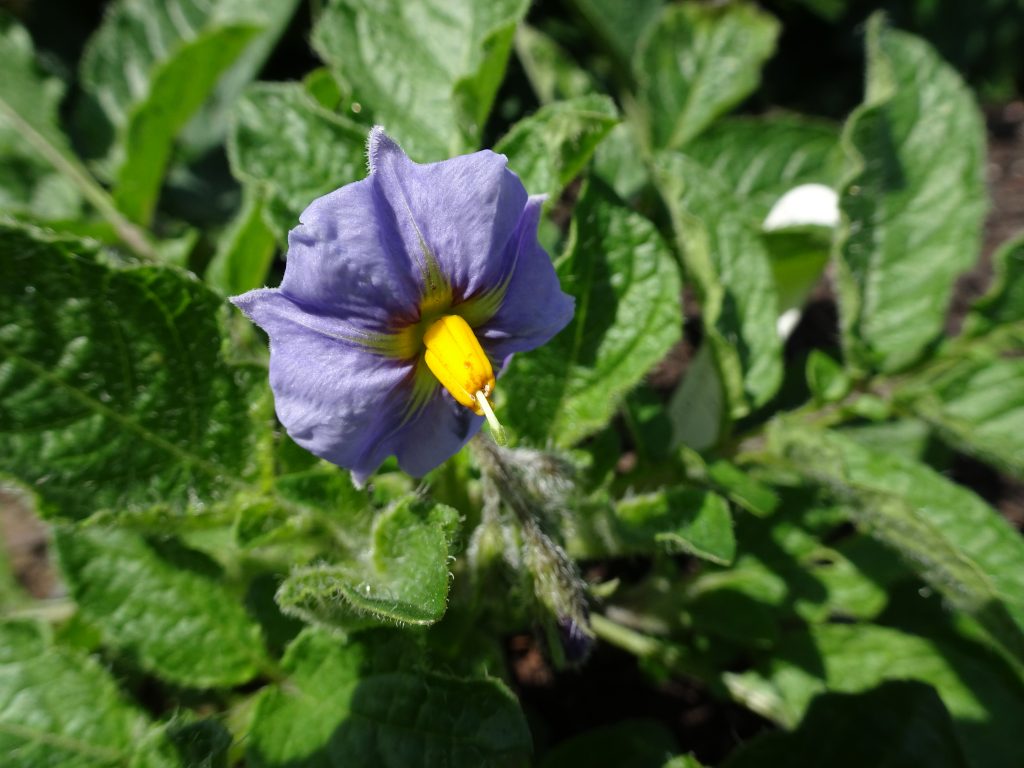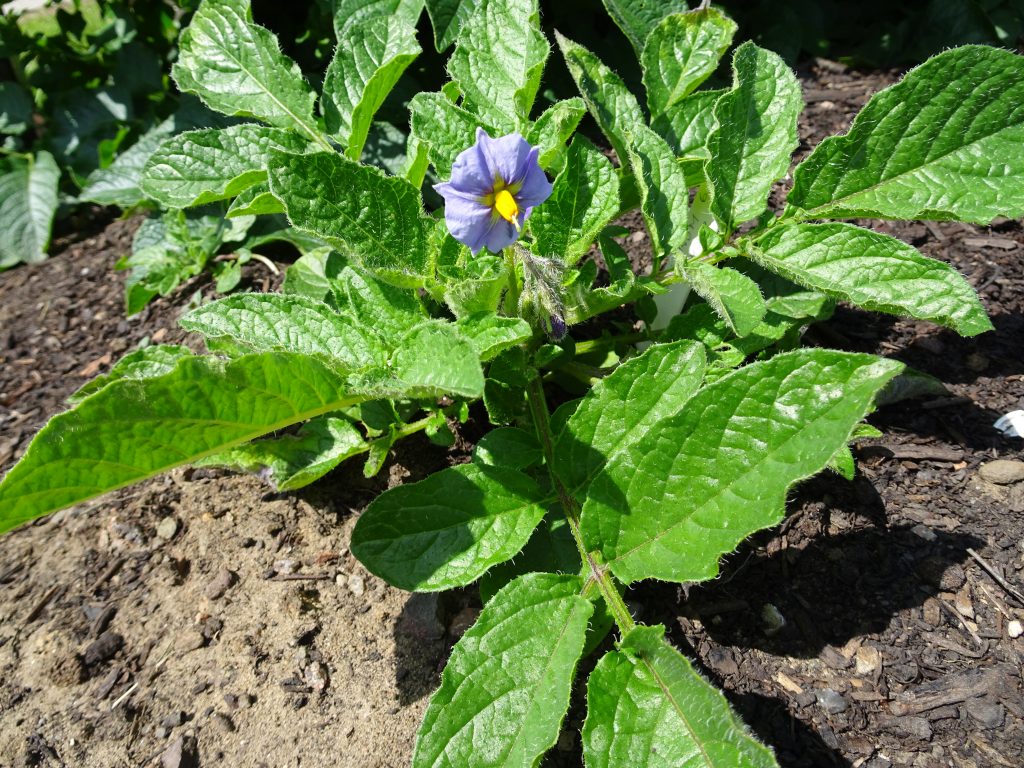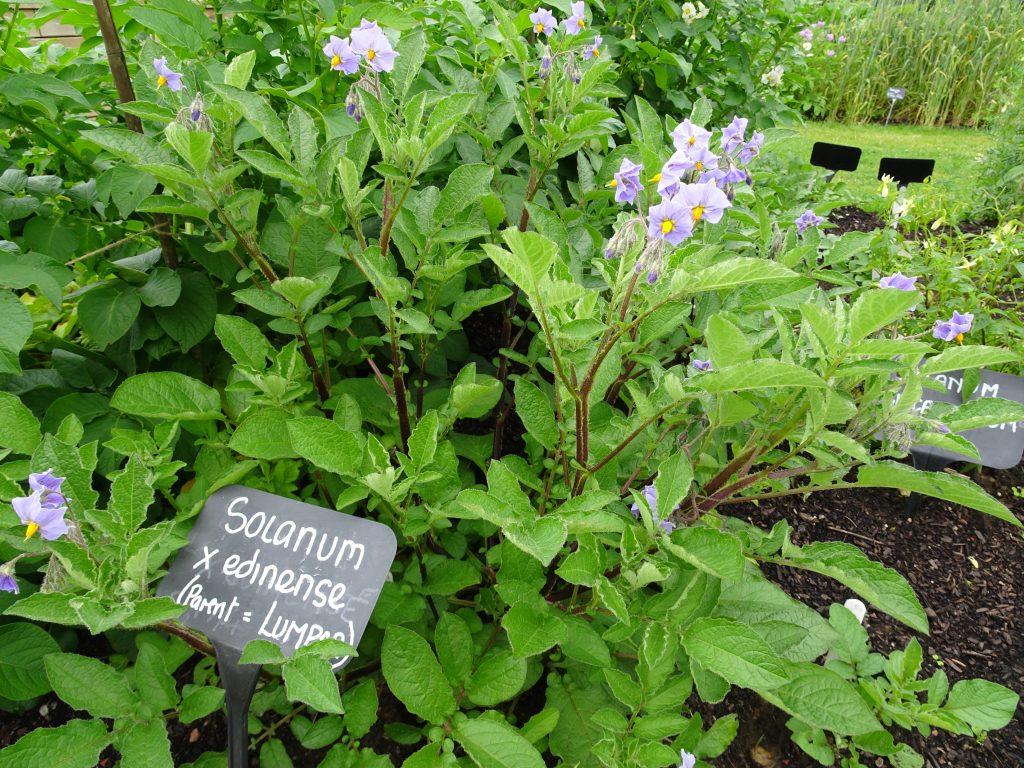The Edinburgh potato is a small piece of the Garden’s historical association with food crops and food security dating back to the time of our Regius Keeper Sir Isaac Bayley Balfour (1853-1922) in the late 19th century. Bayley Balfour was interested in food plants and was well-connected with people in the world of agricultural botany.

Our successful restoration of the Edinburgh potato to the Garden’s collection by a process of controlled hybridisation in 2018 has been a highlight of activity in the Edible Garden this summer. Although the rough story of this potato was known, our success in brining it back after perhaps a gap of around 100 years has led us to ask more questions. When did the Edinburgh potato first arrived at RBGE, who at RBGE was involved, why was RBGE growing potatoes and exactly how did it then reached the French botanist, Berthault, who named it in honour of Edinburgh and the RBGE in 1911? A lot of questions. Some of which still remain unanswered.

Thanks to some expert delving in the archives by Graham Hardy in the Library we now know more of the story of this plant which has an important place in the history of potato breeding and improvement. To put that claim in context the creation of the Edinburgh potato has in fact been the first step on a path to disease-resistant new potato varieties currently grown by farmers.
The description of Solanum xedinense, the Edinburgh potato, published in 1911 tells us that Berthault obtained tubers from Sutton & Sons the famous seed merchant that still trades today under the name Suttons. We also learn that Berthault strongly suspected that the plant he was naming was the product of hybridisation between the domesticated potato and an unknown wild potato species. A suspicion that, in the fullness of time, has proven to be absolutely right.
Knowing that Sutton & Sons were part of the story led to checking the cumulative index of the Journal of the Royal Horticultural Society. This revealed that Arthur W. Sutton (1854-1925), senior partner at Sutton & Sons, had published on potatoes in the Journal of the Royal Horticultural Society in 1896. This paper gives details of where and from whom Sutton had obtained the Edinburgh potato.
The first dispatch was from RBGE in 1887 from Mr Robert Lindsay (1846-1913). Lindsay spent almost all of his horticultural career at RBGE. He entered RBGE as a young teenager, when James McNab was Curator. At McNab’s death in 1878 Lindsay was one of the foreman gardeners. He was appointed Curator in 1883, succeeding John Sadler. He retired in 1896 and developed his own garden at Kaimes Lodge in Corstorphine, specialising in alpines. He was also an authority on hebes and insectivorous plants.
A second dispatch to Sutton took place ten years later in 1897 and was again from RBGE. This time the plants were supplied by the Regius Keeper, Bayley Balfour.
Useful historical details are present in the RHS paper by Sutton. According to Sutton the potato had grown in the same beds at RBGE for “at least thirty years” and, importantly, he also mentions that “When left in the ground all the winter the tubers appeared to be quite unaffected by frost, and no disease had been observed.” It is worth remembering that this was a period shortly after the devastation caused by late blight in Ireland and to a lesser extent in Scotland during the 1840s.
The discovery of Sutton’s RHS paper spurred further searching that unearthed another paper by him in the Journal of the Linnean Society (Botany) in 1908. Here more details of the Edinburgh potato emerge. Sutton comments again on “its remarkable exemption from disease” and notes this could lead to economic potential. Sutton was mistakenly calling the Edinburgh potato Solanum etuberosum, a name he probably took on trust from the RBGE as the ledger records the plants sent to Sutton as being of this species. Sutton’s belief was that because his plants were fertile and produced seedlings showing the wide variation seen in the cultivated potato this species must be ancestral to the potato as we know it in cultivation. This interpretation was wrong.
The Edinburgh potato is in fact the result of a cross between the domesticated potato and a wild Mexican relative Solanum demissum. Its famed disease resistance is the product of genes for resistance to late blight that have been inherited from the Mexican parent. The Edinburgh potato can itself set fruit with viable seeds, but it seems that male sterility is a common problem in this hybrid. Consequently, the seed derived by Sutton from Edinburgh potatoes was likely the result of viable pollen coming from nearby cultivated potatoes. This explains the observation of high variability by Sutton as this second generation of plants would, in terms of their genetic makeup, be roughly 75% domesticated potato and 25% Solanum demissum.

What we still do not know is when RBGE first obtained the potato, or where from? The hybrid is naturally produced in Mexico where potato cultivation overlaps with the natural range of Solanum demissum. This would suggest that the RBGE plants can trace their origin back to plants collected as tubers in Mexico and brought to Europe. However, a second possibility cannot be ignored. The hybrid is readily produced whenever the two parents are grown together and the independent origin of the hybrid could therefore happen repeatedly in gardens in just the same way that it happens repeatedly in the wild in Mexico. So, it is even possible that the Edinburgh plants arose in Edinburgh if the RBGE had received plants of Solanum demissum and grew them near cultivated potatoes. We may never know the answer.
For more on the process of recreating the Edinburgh potato see the blog links below:
Progress with the Edinburgh potato
Edinburgh’s potato: flowers at last
The full details of the process of recreating the Edinburgh potato are published in Sibbaldia: The International Journal of Botanic Garden Horticulture issue 19 available to download here.
